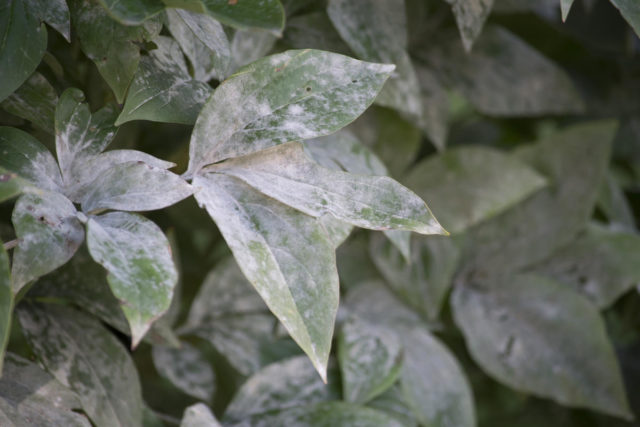Content
Peonies are deservedly considered one of the most decorative flowers and are popular among gardeners. Their bright, large flower hats leave no one indifferent. Among the many species of this plant, the so-called "coral" group stands out, to which the peony Coral Charm belongs.
Description of peony Coral Charm
The ancestor of "coral" peonies can be considered the breeder Arthur Sanders, who at the beginning of the last century for the first time managed to get flowers of such unusual shades as salmon, orange-pink and coral. Later, work in this direction was continued by another scientist, Sam Wissing. It was thanks to him that in the mid-60s of the last century the famous "coral" series of peonies was bred in America, to which Coral Charm belongs.
A brief description of the plant, its main parts and characteristics is presented in the table:
Parameter | Value |
Plant type | Perennial, herbaceous. |
The form | A compact shrub with a rounded crown. Does not require backups. Grows moderately. The average height of the bush is 0.9-1.2 m. |
Escapes | Smooth, straight, green with a reddish tint, powerful. |
Leaves | Elongated lanceolate, with a pointed end, trifoliate with a long petiole. The leaf plate is bright green, dense, with well-read veins, slightly drooping, bent like a boat. |
Root system | Powerful rhizome with several large tuberous roots and a small lobe. |
Flowers | Semi-double, cupped, 15-20 cm in diameter. Consist of many flat, inwardly bent large petals with an uneven edge, surrounding the central part. |
Flowering time | June. |
Illumination requirements | Loves well-lit areas, but without direct sunlight, because of which bright petals quickly fade. Diffused lighting is ideal. In the shade it is strongly stretched, the stem loses its strength. |
The soil | Loose, breathable, fertile enough, well hydrated, slightly alkaline with a PH level of about 7.5. |
Peony Coral Charm, or, as it is sometimes called by flower growers, Coral Charm, has good frost resistance. In areas where the temperature in winter does not fall below -30 ° C, it is quite possible to leave it in the open ground and not even cover it. Moreover, the plants do not freeze even in winters with little snow. This makes it possible to grow peonies of this variety practically throughout the Central part of Russia, as well as in the south of the Urals. In colder regions, leaving the rhizomes in the ground for the winter is dangerous. They must be dug up and removed for the winter in a special room.
Peony flowering features Coral Charm
Coral Charm belongs to varieties with semi-double flowers. Their color at the beginning of flowering is dark pink, then they become coral, a white border appears at the edge, and at the end of life the petals acquire a tangerine color. In the central part of the flower there are bright yellow stamens. The petals are arranged in 8 rows around. That is why the flower looks very lush. After opening, the diameter of its cap can reach 20-22 cm.
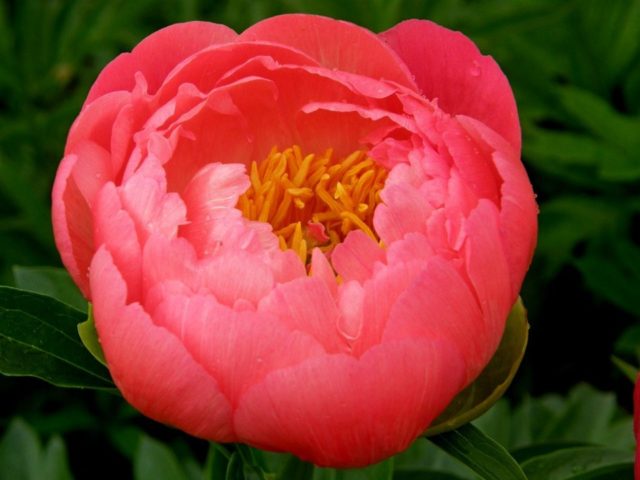
The special splendor of the Coral Charm peony flower is given by 8 rows of petals
Application in design
Coral Charm peonies, like many other varieties of this plant, are usually given the centerpiece of the garden as one of the most beautiful plants. Here are some possible uses for them in landscape design:
- Detached flower bed. Such an island of blooming peonies will look especially exquisite against the background of an emerald green, evenly trimmed lawn.
- Perimeter. Peony bushes often mark the border of the lawn.
- Mixborder. Peonies are planted in combination with other flowering plants.
- Beds of continuous flowering. In this case, the types of flowers are selected in such a way that the flowering of some smoothly passes from one group of plants to others. Peonies in this case are good because, even after flowering, their juicy greenery serves as an excellent background for other, lower in height flowering plants.
- Ceremonial flower bed. It is usually placed near the main entrance to the building. If the size allows, then the flower bed can be made tiered. The Coral Charm peony bush is placed in the center, and less tall flowers of white, red or purple shades are planted around.
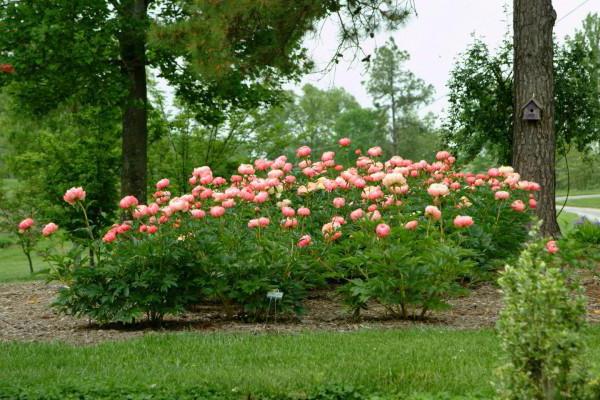
Coral Charm peonies look good next to conifers
Coral Charm peonies go well with needles, against which they can reveal all their beauty. Bulbous ones, for example, tulips, as well as irises, phlox can be planted next to them.
Look great with peony Coral charm roses, which bloom a little later. In this case, the peony, as it were, passes the baton to them, creating the effect of continuous flowering.
Coral Charm peonies are intended for outdoor cultivation. You can try to grow them in pots at home, but with a high degree of probability, such an experiment will be unsuccessful. For growing as potted flowers, it is better to use other varieties of peonies, since among their many there are species specially bred for this purpose.
Reproduction methods
The easiest and most reliable way to propagate Coral Sharm peonies is to divide the rhizome. This operation is performed at the end of summer or at the very beginning of autumn. You can only divide adult bushes, which are at least 7-8 years old. Rhizomes are completely dug out of the ground, washed with a stream of water and dried in air. Then, using a knife, they are divided into fragments, which have independent roots and renewal buds. For disinfection, the sections are powdered with wood ash, and then parts of the rhizomes are planted in the planting pits.

Before dividing the peony rhizome, rinse well
Planting a grassy peony Coral Charm
When deciding to plant a Coral Charm peony, you need to be especially careful when choosing a place, since a flower can grow in one place for many years. The quality of flowers will be affected by both the lack of sunlight and its excess. In the shade, the shoots will stretch out and grow thin, because of this, the bush will fall apart, and under the weight of massive flower caps it can even break. However, direct sunlight should also be avoided. Under the bright rays of the sun, the flower can burn out literally in a day, the petals will become pale and dull, the bush will lose its decorative effect. Therefore, the Coral Sharm peony planting site should be illuminated by diffused sunlight, especially in the middle of the day.
If the soil in the chosen place is not entirely suitable, then it is preliminarily prepared by adding humus, sand, dolomite flour or lime is added to reduce acidity. Planting is carried out in early autumn, it is at this time that the Coral Sharm peony bushes are divided for reproduction. It is best to dig the planting holes a few weeks before the planting date. Since it is imperative to lay a drainage layer on the bottom, the depth of the hole should be at least 0.6 m.
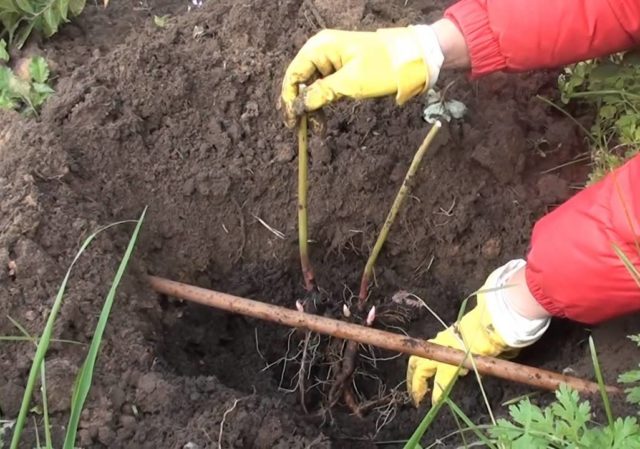
The depth of the seedling can be easily checked with an ordinary stick lying on the ground.
A delen or a seedling from a container is carefully placed in the center of the pit and covered with prepared soil mixture, which includes soil removed from the pit, compost, as well as a small amount of superphosphate (200 g) and potassium sulfate (40 g).
Follow-up care
Caring for Coral Charm peonies is not difficult. With a lack of atmospheric moisture 3-4 times a month, 1-2 buckets of rain or settled water are poured under each bush.
In the first year after planting, peonies are not fed. Starting from 2 years old, fertilizers are applied in several stages:
Period | Fertilizer type and dosage | Method of application |
Spring, before budding | Ammonium nitrate 15-20 g Superphosphate 20 g Potassium sulfate 20 g | Dilute in 10 liters of water, add to the root zone |
The emergence of buds | Ammonium nitrate 30 g Superphosphate 35-400 g Potassium sulfate 40 g | -//- |
After flowering is complete | Any potash and phosphate fertilizers, 15-20 g of each of the components | -//- |
Autumn | Horse dung | Root zone mulching |
During the flowering period, many gardeners use yeast feeding (10 g of dry yeast and 3 tablespoons of sugar per 10 liters of water). The resulting infusion is diluted with clean water 1: 5 and watered in the root zone.
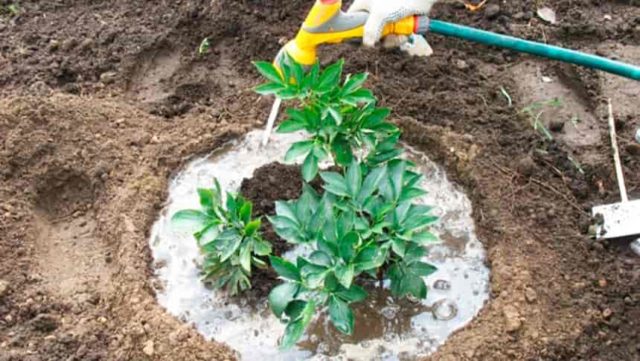
Watering and feeding is convenient to make in the circular grooves made around the perimeter of the peony bush
The peony bush Coral Charm does not need to form, since it does not have lateral buds. Another care measure is loosening and mulching the root zone. This should be done regularly, especially when a crust forms on the soil surface. Ordinary garden soil is used as mulch, since the materials traditionally used for this (peat, coniferous litter, bark) acidify the soil, and the peony does not need it.
Preparing for winter
No special preparation for the cold weather is required for Coral Charm peonies, since in Central Russia they are able to winter without shelter. With the arrival of the first frost, all the stems are cut almost to the root, leaving only small stumps.
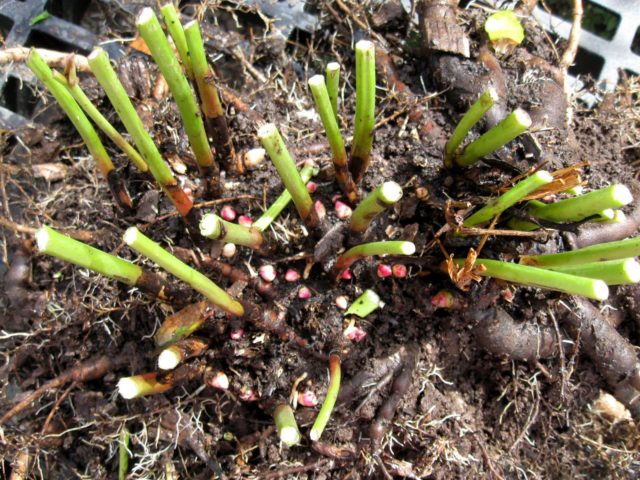
Before wintering, all peony shoots are cut to hemp
From above they are covered with a layer of humus, compost or crushed horse manure, and with the arrival of winter they are simply covered with snow.
Pests and diseases
Peony Coral Charm is most often affected by various fungal diseases. They appear in the form of spots on the leaves, blackening and the appearance of rot on various parts of the plant. They can be caused by both disturbances in care and unfavorable weather conditions. Here are the most common Coral Charm peony diseases:
- Powdery mildew. It is detected by light gray rashes on the leaves. Subsequently, the affected areas quickly turn black and rot. When powdery mildew appears, the infected shoots are cut out, and the plants are treated with fungicides.
A grayish bloom on the leaves is a sign of powdery mildew.
- Gray rot. It can be diagnosed by brown specks at the base of the shoots and on small buds. To avoid further development of the disease, the affected shoots are cut out and burned, and the plant is treated with a solution of potassium permanganate or Fundazol.
Gray rot appears at the base of the shoots
- Cladosporium. This disease can be recognized by dark spots of irregular shape, which in most cases appear only on the leaves. To combat cladosporia, drugs containing copper are used, for example, copper oxychloride.
Irregular dark spots on the leaves may indicate the defeat of the peony by cladosporium.
Coral Charm peonies have few pests. The greatest danger to them is represented by bronzes, eating buds and young flowers, and sometimes leaves. Since these are rather large beetles, it is best to simply pick them up with your hands every morning, at which time they are the least mobile.
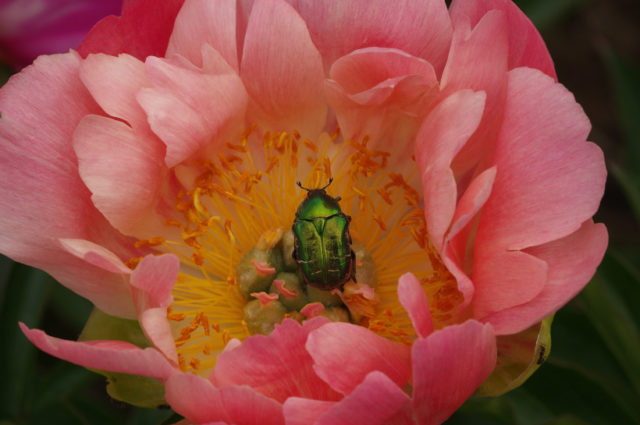
Bronzes from peony flowers are easy to collect by hand, they do not bite
Ants are another common pest of Coral Charm peonies.These small insects are attracted by the sweet floral scent. You can get rid of ants using the drugs Muratsid or Anteater.
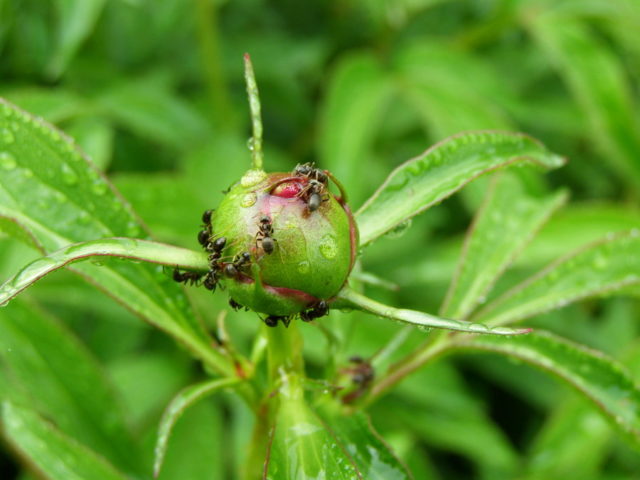
Ants are not only able to eat a peony, but they can also bring aphids to plants.
Conclusion
Peony Coral Charm can become a real decoration of the local area or garden. This plant is undemanding to care for, adapted to unfavorable weather conditions and tolerates Russian winters well. Coral Charm peony flowers not only look great, but also have a delicate aroma, filling the garden with a real fragrance during flowering.
